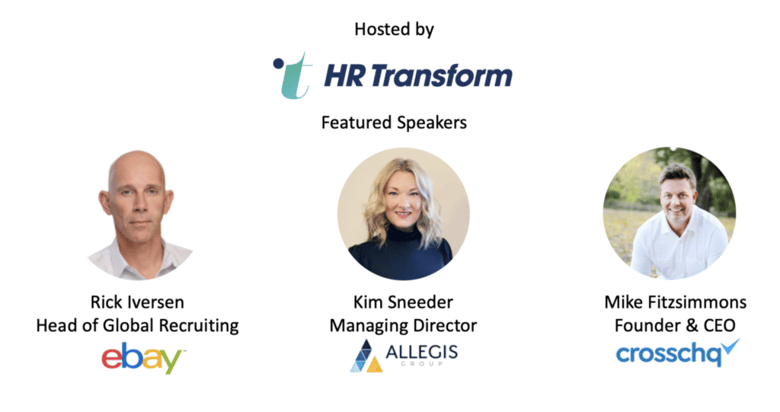Written by Chris Drake | Feb 26, 2021 8:12:00 AM

“You have to slow down to speed up.”
Key Takeaway #1: In recruiting, we all want to focus on quality over speed, but it’s really hard.
- Mike Fitzsimmons: “Only 11% of new hires fail because of technical skills. Most of the high new-hire failure rate is driven by personality, managerial, or culture mismatches.”
- Rick Iversen: “People are in such a rush to get hiring, to fill a seat, but you can’t skip over the details. There has to be a profile of what makes a successful candidate for your company and then mine for candidate data that matches the profile. You have to slow down to speed up.”
- Kim Sneeder: “People think about quality candidates as line items on a resume. Where did they work previously? What school did they graduate from? But we need to move beyond the resume and understand what motivates them, what makes them successful environmentally that we can use to foster their development and therefore their success.”
Key Takeaway #2: Tools for consistent Quality of Hire measurement are lacking.
- Rick Iversen: “Recruiting needs to own it (quality of hire measurement) and be the tip of the spear. There’s a link between recruiting and employee exit data that has to be connected. We as recruitiers have to understand why people leave to identify pre-hire red-flags. There has to be a single source of truth for full employee lifecycle management, from sourcing through onboarding through exit and an investment has to be made to learn from that analysis and most importantly, take action on that data.”
- Kim Sneeder: Again, we have to go beyond the resume. We have to change what metrics are measured for recruiting success. We have to have more conversations with our candidates to figure out what they need to be successful. And we have to have conversations with hiring managers about why employees are successful on their teams. It’s easy to see if someone did the job before, but we need consistent analytics and employee profiles that show us what a quality candidate looks like as a person before we can find candidates that we know will be a match.”
Key Takeaway #3: It’s not only about new tools to get better candidate intelligence.
- Rick Iversen: “It’s almost a completely lost art and skill of talent acquisition teams to find out who a candidate is, not just the work they’ve done. It’s less about investing in new products; most companies have great assessment tools and CRM systems. Its about a company being willing to pull all the data together and really build a 360 view of the candidate and then partnering with hiring teams. The entire enterprise needs to buy into a better hiring process and invest in tying hiring plans to business outcomes.”
- Kim Sneeder: “We do personality assessments, behavioral assessments, we use Crosschq to find candidate information from former peers and managers, and it certainly helps better inform hiring decisions. But talking to candidates, really giving them a platform whether it’s a video introduction or time to chat with a (hiring) team member, to show us who they are is key. They have skills, they have hobbies, they have interests that will help them be successful in a new role that can’t be found on their resume or Linkedin.”
Key Takeaway #4: Focusing on quality hiring will naturally drive diversity and inclusion.
- Kim Sneeder: “Focus on human insights at the bottom of the hiring funnel, and AI or matching to help at the top, so long as unconscious bias is mitigated. But we have to cast a wider net, and ensure that the top of our hiring funnel covers as many underrepresented groups as possible. And once minority candidates are in the funnel, they must be treated as unique individuals and not business goal, even if diversity is business focus. Diversity candidates are people, not a box to check.”
- Rick Iversen: “If you want an inclusive funnel, you have to be willing to invest in your employees from day 1 and upskill them into new and future roles. If you can’t show candidates that you’re investing in and developing their peers, they won’t believe you’re going to be invested in them. Be honest about where you’re at in the DNI innovation process, and then challenge yourself to get better. It can’t be about hollow promises, big announcements or splashy hiring events. DEI has to be a goal supported across the company. Embedding in underrepresented communities and creating a hiring process that is inclusive, that spans the spectrum, and making it a repetitive process is a good way to start.”
Key Takeaway #5: It’s time to re-think how we incentivize our TA & recruiting teams
- Kim Sneeder: “Speed is good if your getting quality candidates fast. But at the end of the day, a lot of times it comes back to compensation. Recruiters need to compensated for finding and hiring employees that have a long tenure and are top performers instead of quotas filled or reduction in time to hire. If you incentivize the right metrics, the desired outcomes will follow. Slow down to speed up.”
- Rick Iversen: “TA needs to move from a transactional approach to hiring to a consultative approach with their business partners, and it must be a partnership with the hiring teams they work with, not for. But they need better data to lead the conversation.”
